Rain Cover and Netting Materials Differentially Affect Fruit Yield and Quality Traits in Two Highbush Blueberry Cultivars via Changes in Sunlight and Temperature Conditions
Abstract
:1. Introduction
2. Results
2.1. Woven and LDPE Covers Boost Yield by Enhancing Microclimate and LAI and Reducing UV Exposure
2.2. UV-Exposed Control and Netting-Covered Fruits Showed Increased Firmness; LDPE and Woven Covers Decreased Firmness
2.3. Netting Maintains Firmness by Lowering Air Temperature
2.4. Soluble Solids Exhibit Variations Based on Cover Type and Cultivar, Impacting Fruit Composition
2.5. Achieving Optimal Quality and Yield through Empirical Cover, Cultivar, and Material Selection
3. Discussion
3.1. UV Light Exposure Effects on Yield and Fruit Firmness
3.2. The Significance of Cuticle Thickness in Regulating Fruit Firmness
3.3. Temperature’s Role in Influencing Yield and Fruit Firmness
3.4. Genetic Variability and Cultivar-Specific Responses
3.5. Implications for Selecting Suitable Cover Materials
3.6. Exploring Variability in Total Soluble Solids and Its Environmental Implications
4. Materials and Methods
4.1. Study Sites
4.2. Plant Material and Experimental Design
4.3. Light and Temperature Conditions
4.4. Yield Components and Fruit Quality Traits
4.5. Data Analysis
5. Conclusions
Author Contributions
Funding
Data Availability Statement
Acknowledgments
Conflicts of Interest
References
- Larrañaga, P.; Osores, M.A. Fruit Cadastre. Main Results; ODEPA-CIREN: Santiago, Chile, 2019; p. 35. [Google Scholar]
- González, A.; Morales, C.G. Blueberry varieties. In Blueberry Agronomic Management Manual, 1st ed.; Morales, C.G., Ed.; Instituto de Investigaciones Agropecuarias: Santiago, Chile, 2017; pp. 11–19. [Google Scholar]
- Morales, C.G.; González, J. Blueberries and Raspberries in the Maule Region: Sectoral Characterization and Varietal Analysis; Instituto de Investigaciones Agropecuarias: Santiago, Chile, 2022; p. 134. [Google Scholar]
- Fang, Y.; Nunez, G.; Da Silva, M.; Phillips, D.; Munoz, P.A. Review for southern highbush blueberry alternative production systems. Agronomy 2020, 10, 1531. [Google Scholar] [CrossRef]
- Bastías, R.M.; Boini, A. Apple Production under Protective Netting Systems. In Apple Cultivation—Recent Advances, 1st ed.; Küden, A., Ed.; IntechOpen: London, UK, 2022; pp. 91–102. [Google Scholar]
- Bastías, R.M.; Leyton, M.J. Production of cherry trees under woven and plastic: Effects on the microclimate, quality fruit condition. Rev. Frutic. 2018, 40, 8–14. [Google Scholar]
- Ogden, A.B.; Van Iersel, M.W. Southern highbush blueberry production in high tunnels: Temperatures, development, yield, and fruit quality during the establishment years. HortScience 2009, 44, 1850–1856. [Google Scholar] [CrossRef]
- Retamal-Salgado, J.; Bastías, R.M.; Wilckens, R.; Paulino, L. Influence of microclimatic conditions under high tunnels on the physiological and productive responses in blueberry ‘O’Neal’. Chil. J. Agric. Res. 2015, 75, 291–297. [Google Scholar] [CrossRef]
- Renquist, S. An evaluation of blueberry cultivars grown in plastic tunnels in Douglas County, Oregon. Int. J. Fruit Sci. 2005, 5, 31–38. [Google Scholar] [CrossRef]
- Hicklenton, P.; Forney, C.; Domytrak, C. Row covers to delay or advance maturity in highbush blueberry. Small Fruits Rev. 2004, 3, 169–181. [Google Scholar] [CrossRef]
- Retamales, J.B.; Montecino, J.M.; Lobos, G.A.; Rojas, L.A. Colored shading nets increase yields and profitability of highbush blueberries. Acta Hortic. 2008, 770, 193–197. [Google Scholar] [CrossRef]
- Lobos, G.A.; Retamales, J.B.; Hancock, J.F.; Flore, J.A.; Romero-Bravo, S.; del Pozo, A. Productivity and fruit quality of Vaccinium corymbosum cv. Elliott under photo-selective shading nets. Sci. Hortic. 2013, 153, 143–149. [Google Scholar] [CrossRef]
- Baeza, E.; López, J.C. Light transmission through greenhouse covers. Acta Hortic. 2012, 956, 425–440. [Google Scholar] [CrossRef]
- Castellano, S.; Hemming, S.; Russo, G. The influence of colour on radiometric performances of agricultural nets. Acta Hortic. 2008, 801, 227–236. [Google Scholar] [CrossRef]
- Abdel-Ghany, A.M.; Al-Helal, I.M.; Shady, M.R.; Ibrahim, A.A. Convective heat transfer coefficients between horizontal plastic shading nets and air. Energy Build. 2015, 93, 119–125. [Google Scholar] [CrossRef]
- Salazar-Canales, F.; Bastías, R.M.; Calderón-Orellana, A.; Wilckens, R.; González, E. Photo-selective nets differentially affect microclimatic conditions, leaf physiological characteristics, and yield in hazelnut (Corylus avellana L.). Hortic. Environ. Biotechnol. 2021, 62, 845–858. [Google Scholar] [CrossRef]
- Salvadores, Y.; Bastías, R.M. Environmental factors and physiological responses of sweet cherry production under protective cover systems: A review. Chil. J. Agric. Res. 2023, 83, 484–496. [Google Scholar] [CrossRef]
- Obsiea, E.Y.; Qub, H.; Drummond, F. Wild blueberry yield prediction using a combination of computer simulation and machine learning algorithms. Comp. Electron. Agric. 2020, 178, 105778. [Google Scholar] [CrossRef]
- Ballaré, C.L.; Pierik, R. The shade-avoidance syndrome: Multiple signals and ecological consequences. Plant Cell Environ. 2017, 40, 2530–2543. [Google Scholar] [CrossRef]
- Katsoulas, N.; Bari, A.; Papaioannou, C. Plant responses to UV blocking greenhouse covering materials: A review. Agronomy 2020, 10, 1021. [Google Scholar] [CrossRef]
- Kossuth, S.V.; Biggs, R.H. Ultraviolet radiation affects blueberry fruit quality. Sci. Hortic. 1981, 14, 145–150. [Google Scholar] [CrossRef]
- Anthony, B.; Serra, S.; Musacchi, S. Optimization of light Interception, leaf area and yield in “WA38”: Comparisons among training systems, rootstocks and pruning techniques. Agronomy 2020, 10, 689. [Google Scholar] [CrossRef]
- Johnson, R.S.; Lakso, A.N. Approaches to modeling light interception in orchards. HortScience 1991, 26, 1002–1003. [Google Scholar] [CrossRef]
- Maib, K.M.; Andrews, P.K.; Lang, G.A.; Mullinix, K. Tree Fruit Physiology: Growth and Development: A Comprehensive Manual for Regulating Deciduous Tree Fruit Growth and Development, 1st ed.; Good Fruit Growers: Wenatchee, WA, USA, 1996; p. 165. [Google Scholar]
- Bastías, R.M.; Manfrini, L.; Grappadelli, L.C. Exploring the potential use of photo-selective nets for fruit growth regulation in apple. Chil. J. Agric. Res. 2012, 72, 224–231. [Google Scholar] [CrossRef]
- Oyarzún, R.; Stöckle, C.; Wu, J.; Whiting, M. In field assessment on the relationship between photosynthetic active radiation (PAR) and global solar radiation transmittance through discontinuous canopies. Chil. J. Agric. Res. 2011, 71, 122–131. [Google Scholar] [CrossRef]
- Retamales, J.B.; Hancock, J.F. Blueberries, 2nd ed.; CABI: Boston, MA, USA, 2012; p. 336. [Google Scholar]
- Inostroza-Blancheteau, C.; Acevedo, P.; Loyola, R.; Arce-Johnson, P.; Alberdi, M.; Reyes-Díaz, M. Short-term UV-B radiation affects photosynthetic performance and antioxidant gene expression in highbush blueberry leaves. Plant Physiol. Biochem. 2016, 107, 301–309. [Google Scholar] [CrossRef]
- Rojas-Lillo, Y.; Alberdi, M.; Acevedo, P.; Inostroza-Blancheteau, C.; Rengel, Z.; de la Luz Mora, M.; Reyes-Díaz, M. Manganese toxicity and UV-B radiation differentially influence the physiology and biochemistry of highbush blueberry (Vaccinium corymbosum) cultivars. Funct. Plant Biol. 2013, 41, 156–167. [Google Scholar] [CrossRef] [PubMed]
- Wang, H.; Guo, Y.; Zhu, J.; Yue, K.; Zhou, K. Characteristics of mango leaf photosynthetic inhibition by enhanced UV-B radiation. Horticulturae 2021, 7, 557. [Google Scholar] [CrossRef]
- Martin, L.B.; Rose, J.K. There’s more than one way to skin a fruit: Formation and functions of fruit cuticles. J. Exp. Bot. 2013, 65, 4639–4651. [Google Scholar] [CrossRef] [PubMed]
- Benítez, J.J.; Gonzalez Moreno, A.; Guzmán-Puyol, S.; Heredia-Guerrero, J.A.; Heredia, A.; Domínguez, E. The response of tomato fruit cuticle membranes against heat and light. Front. Plant Sci. 2022, 12, 807723. [Google Scholar] [CrossRef]
- Rosenquist, J.K.; Morrison, J.C. Some factors affecting cuticle and wax accumulation on grape berries. Am. J. Enol. Vitic. 1989, 40, 241–244. [Google Scholar] [CrossRef]
- Yang, F.H.; Bryla, D.R.; Strik, B.C. Critical temperatures and heating times for fruit damage in northern highbush blueberry. HortScience 2019, 54, 2231–2239. [Google Scholar] [CrossRef]
- Liu, G.S.; Li, H.L.; Peng, Z.Z.; Liu, R.L.; Han, Y.C.; Wang, Y.X.; Zhao, X.D.; Fu, D.Q. Composition, metabolism and postharvest function and regulation of fruit cuticle: A review. Food Chem. 2023, 411, 135449. [Google Scholar] [CrossRef]
- Lara, I.; Belge, B.; Goulao, L.F. The fruit cuticle as a modulator of postharvest quality. Postharvest Biol. Technol. 2014, 87, 103–112. [Google Scholar] [CrossRef]
- Johnson, R.S.; Lakso, A.N. Relationships between stem length, leaf area, stem weight, and accumulated growing degree-days in apple shoots. J. Am. Soc. Hortic. Sci. 1985, 110, 586–590. [Google Scholar] [CrossRef]
- Xu, R.; Dai, J.; Luo, W.; Yin, X.; Li, Y.; Tai, X.; Han, L.; Chen, Y.; Lin, L.; Li, G.; et al. A photothermal model of leaf area index for greenhouse crops. Agric. For. Meteorol. 2010, 150, 541–552. [Google Scholar] [CrossRef]
- Ogden, A.B.; Kim, J.; Radcliffe, C.A.; Van Iersel, M.W.; Donovan, L.A.; Sugiyama, A. Leaf and bud temperatures of southern highbush blueberries (Vaccinium corymbosum) inside high tunnels. Acta Hortic. 2009, 893, 1319–1325. [Google Scholar] [CrossRef]
- Moggia, C.; Graell, J.; Lara, I.; González, G.; Lobos, G.A. Firmness at harvest impacts postharvest fruit softening and internal browning development in mechanically damaged and non-damaged highbush blueberries (Vaccinium corymbosum L.). Front. Plant Sci. 2017, 8, 535. [Google Scholar] [CrossRef] [PubMed]
- Brüggenwirth, M.; Fricke, H.; Knoche, M. Biaxial tensile tests identify epidermis and hypodermis as the main structural elements of sweet cherry skin. Ann. Bot. Plants. 2014, 6, plu019. [Google Scholar] [CrossRef]
- Lang, A.; Düring, H. Grape berry splitting and some mechanical properties of the skin. Vitis 1990, 29, 61–70. [Google Scholar]
- Woolf, A.B.; Wexler, A.; Prusky, D.; Kobiler, E.; Lurie, S. Direct sunlight influences postharvest temperature responses and ripening of five avocado cultivars. J. Am. Soc. Hortic. Sci. 2000, 125, 370–376. [Google Scholar] [CrossRef]
- Atkinson, C.; Lorraine Taylor, L.; Gail Kingswell, G. The importance of temperature differences, directly after anthesis, in determining growth and cellular development of Malus fruits. J. Hortic. Sci. Biotechnol. 2001, 76, 721–731. [Google Scholar] [CrossRef]
- Paniagua, A.C.; East, A.R.; Hindmarsh, J.P.; Heyes, J. Moisture loss is the major cause of firmness change during postharvest storage of blueberry. Postharvest Biol. Technol. 2013, 79, 13–19. [Google Scholar] [CrossRef]
- Lecourieux, F.; Kappel, C.; Pieri, P.; Charon, J.; Pillet, J.; Hilbert, G.; Renaud, C.; Gomes, E.; Delrot, S.; Lecourieux, D. Dissecting the biochemical and transcriptomic effects of a locally applied heat treatment on developing Cabernet Sauvignon grape berries. Front. Plant Sci. 2017, 8, 53. [Google Scholar] [CrossRef] [PubMed]
- Salvo, S.; Muñoz, C.; Ávila, J.; Bustos, J.; Ramírez-Valdivia, M.; Silva, C.; Vivallo, G. An estimate of potential blueberry yield using regression models that relate the number of fruits to the number of flower buds and to climatic variables. Sci. Hortic. 2012, 133, 56–63. [Google Scholar] [CrossRef]
- Degaetano, A.T.; Shulman, M.D. A statistical evaluation of the relationship between cranberry yield in New Jersey and meteorological factors. Agric. For. Meteorol. 1987, 40, 323–342. [Google Scholar] [CrossRef]
- Chu, W.; Gao, H.; Cao, S.; Fang, X.; Chen, H.; Xiao, S. Composition and morphology of cuticular wax in blueberry (Vaccinium spp.) fruits. Food Chem. 2017, 219, 436–442. [Google Scholar] [CrossRef] [PubMed]
- Li, X.; Li, C.; Sun, J.; Jackson, A. Dynamic changes of enzymes involved in sugar and organic acid level modification during blueberry fruit maturation. Food Chem. 2020, 309, 125617. [Google Scholar] [CrossRef] [PubMed]
- Mupambi, G.; Anthony, B.M.; Layneb, D.R.; Musacchi, S.; Serra, S.; Schmidt, T.; Kalcsitsa, L.A. The influence of protective netting on tree physiology and fruit quality of apple: A review. Sci. Hortic. 2018, 236, 60–72. [Google Scholar] [CrossRef]
- Santibáñez, F.; Santibáñez, P.; Caroca, C.; González, P. Agroclimatic Atlas of Chile, 1st ed.; Centro de Agricultura y Medioambiente: Santiago, Chile, 2017; p. 82. [Google Scholar]
- Olivares-Soto, H.; Bastías, R.M.; Calderón-Orellana, A.; López, M.D. Sunburn control by nets diferentially afects the antioxidant properties of fruit peel in ‘Gala’ and ‘Fuji’ apples. Hortic. Environ. Biotechnol. 2020, 61, 241–254. [Google Scholar] [CrossRef]
- Nobel, P.S. Physicochemical and Environmental Plant Physiology, 4th ed.; Academic Press: London, UK, 2009; p. 582. [Google Scholar]
- Wünsche, J.N.; Lakso, A.N.; Robinson, T.L. Comparison of four methods for estimating total light interception by apple trees of varying forms. HortScience 1995, 30, 272–276. [Google Scholar] [CrossRef]
- McMaster, G.S.; Wilhelm, W.W. Growing degree-days: One equation, two interpretations. Agric. For. Meteorol. 1997, 87, 291–300. [Google Scholar] [CrossRef]
- Balzarini, M.G.; González, L.; Tablada, M.; Casanoves, F.; Di Rienzo, J.A.; Robledo, C.W. InfoStat: Statistical Software, 1st ed.; Brujas: Córdoba, Argentina, 2008; p. 329. [Google Scholar]
- R Core Team. R: A Language and Environment for Statistical Computing; R Foundation for Statistical Computing: Vienna, Austria. Available online: https://www.R-project.org/ (accessed on 27 March 2023).
- Package ‘agricolae’ Statistical Procedures for Agricultural Research. R Package Version 1.3-5. Available online: https://CRAN.R-project.org/package=agricolae (accessed on 15 July 2023).
- Pietrelli, L. Polypropylene recovery and recycling from mussel nets. Polymers 2022, 14, 3469. [Google Scholar] [CrossRef]
- Mukherjee, A.; Knoch, S.; Chouinard, G.; Tavares, J.R.; Dumont, M.J. Use of bio-based polymers in agricultural exclusion nets: A perspective. Biosyst. Eng. 2019, 180, 121–145. [Google Scholar] [CrossRef]
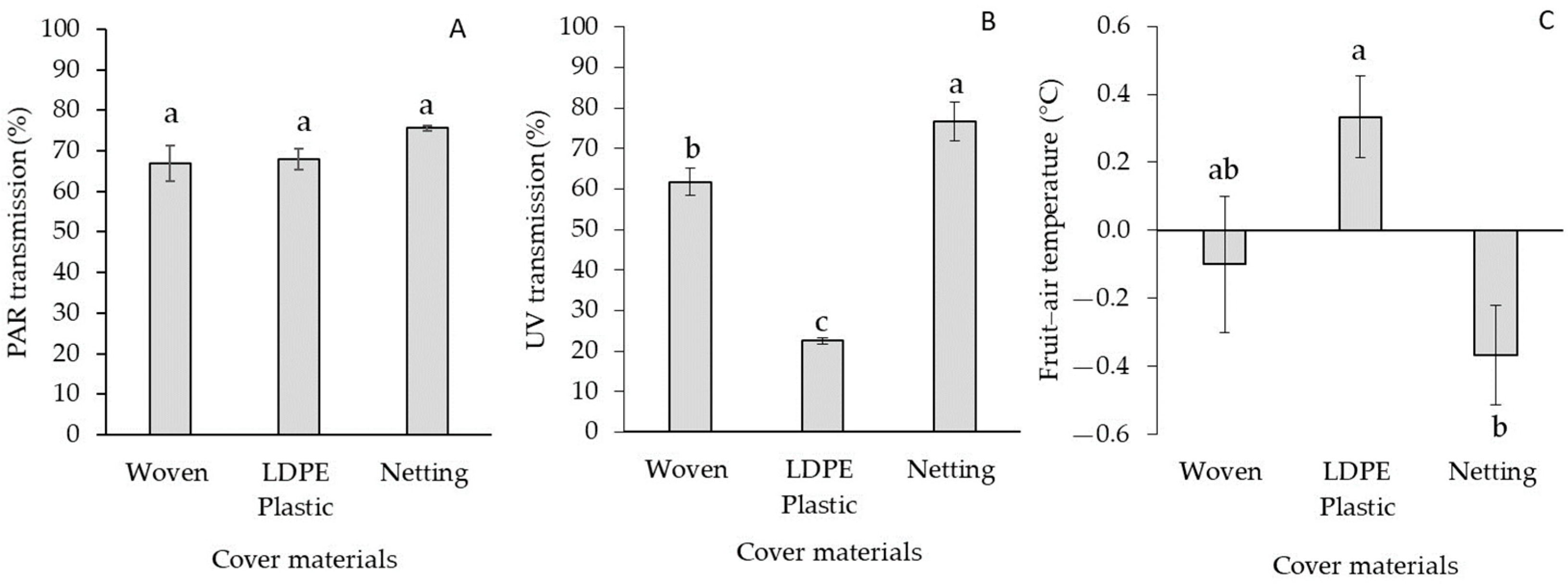
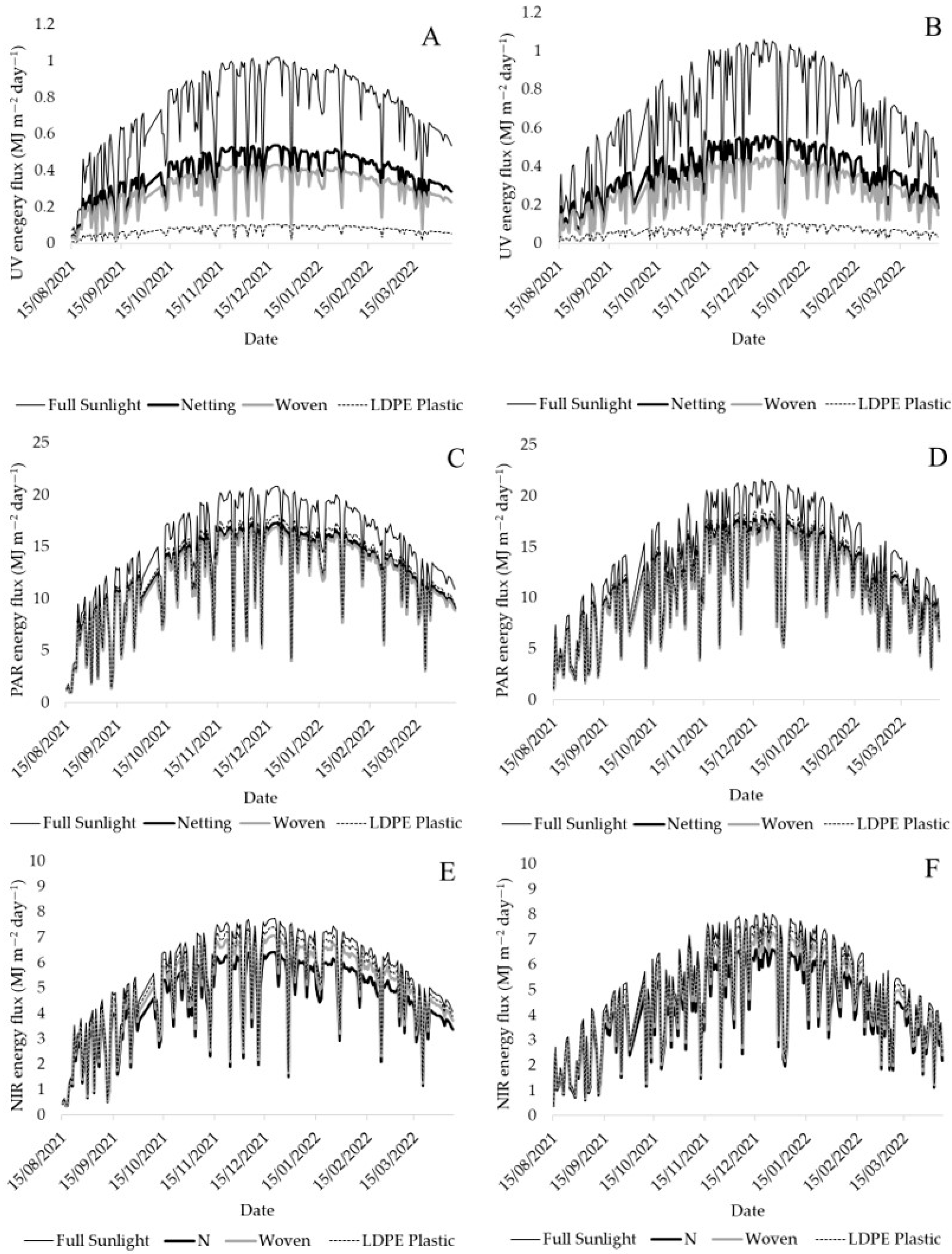


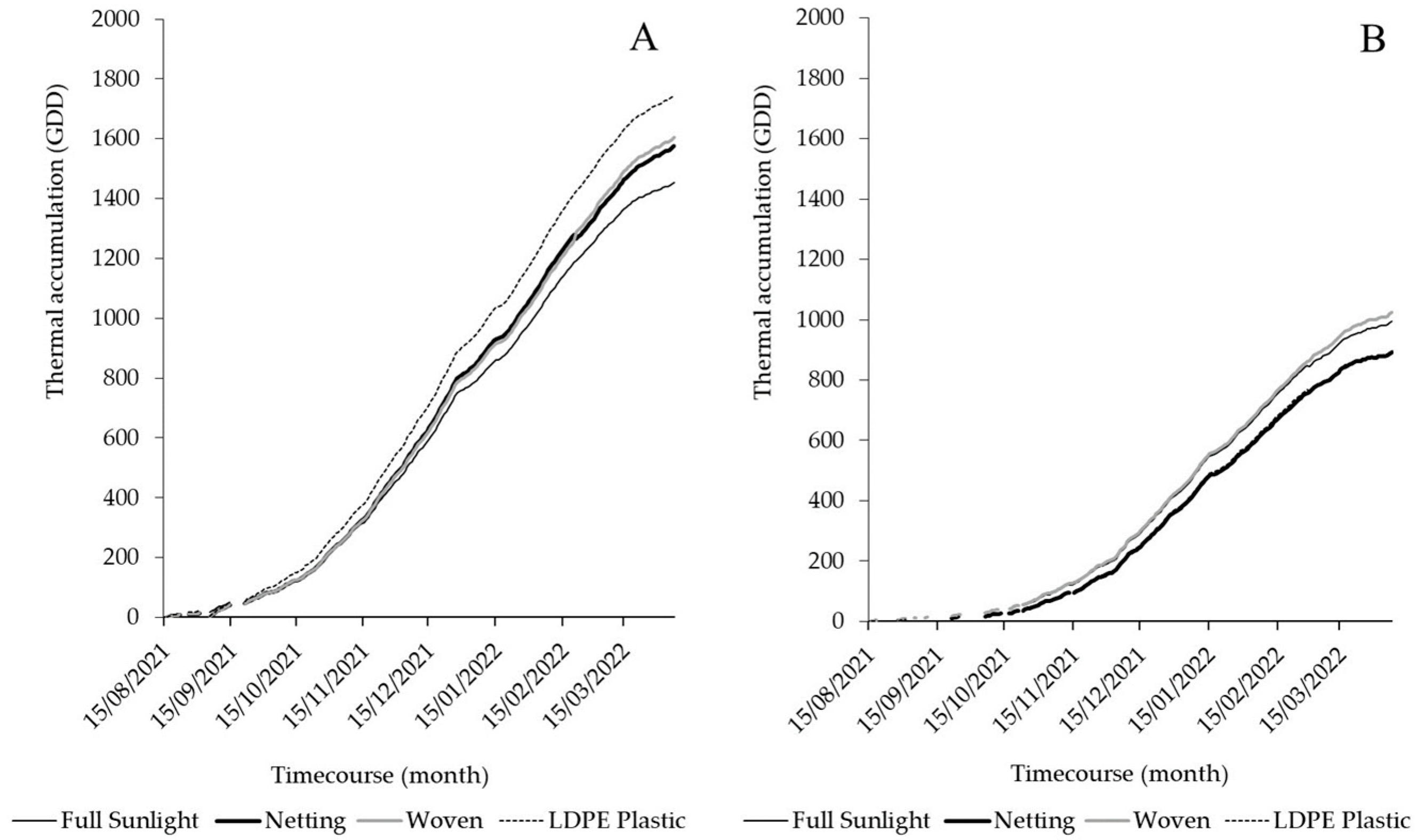
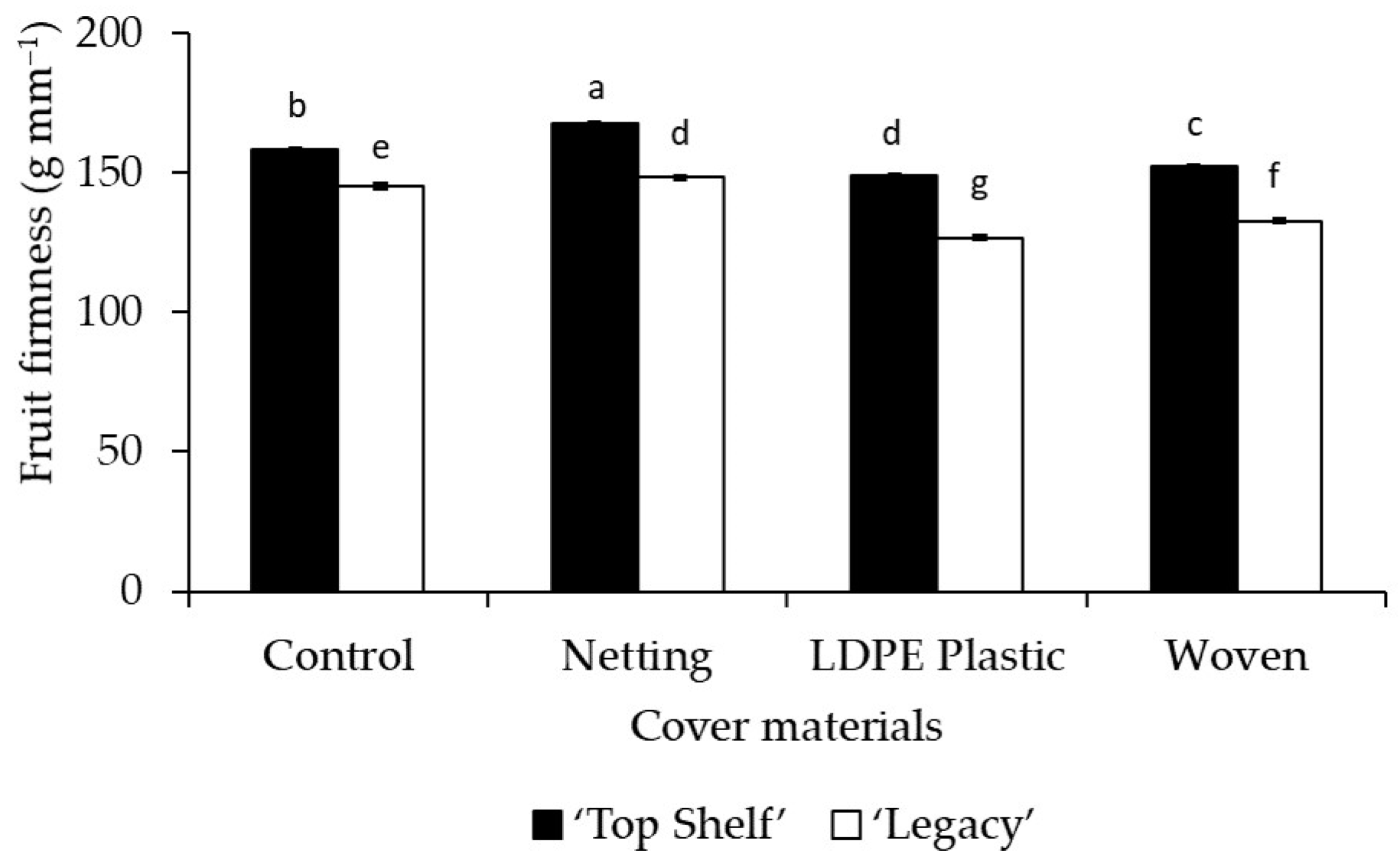
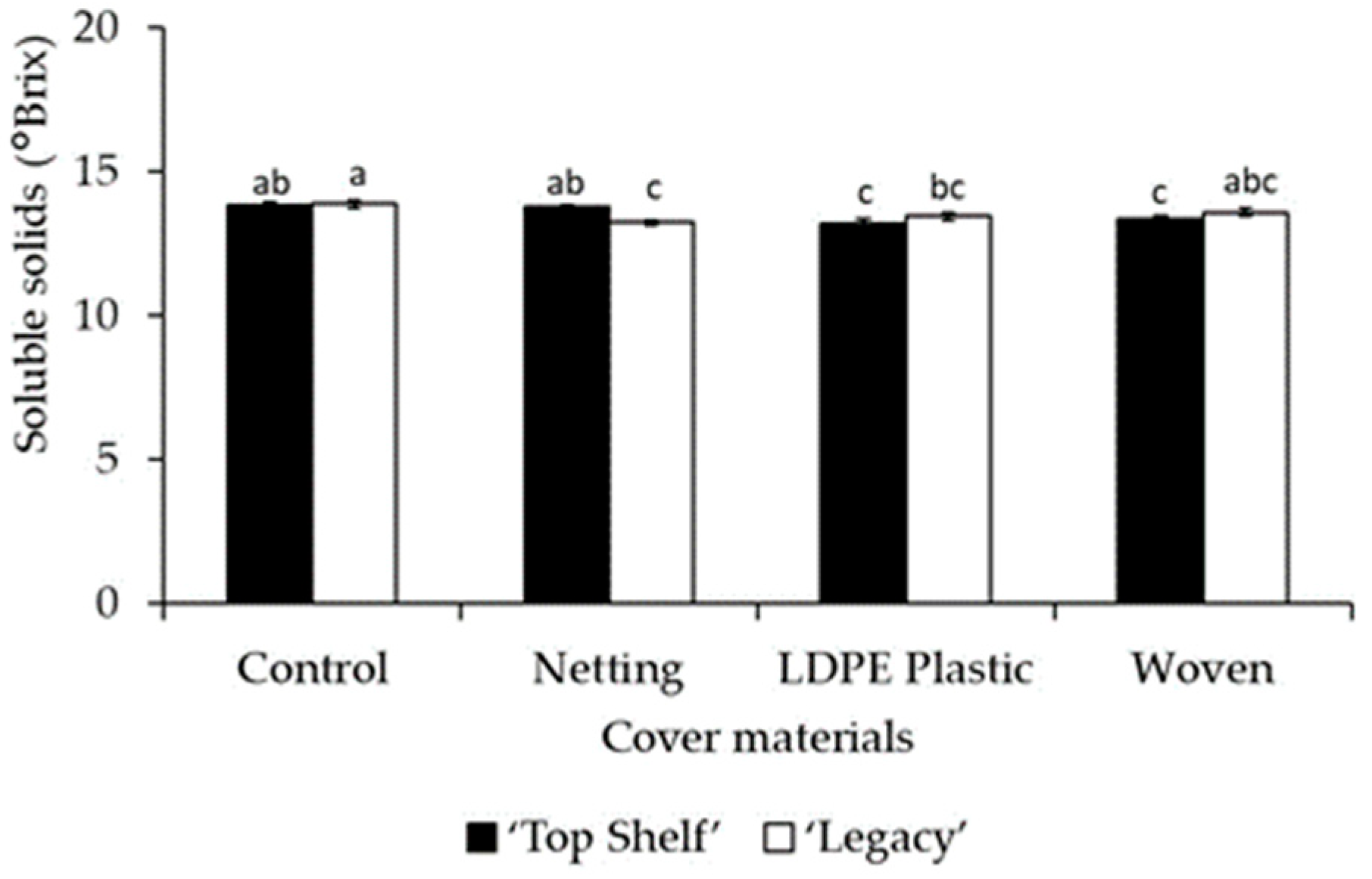
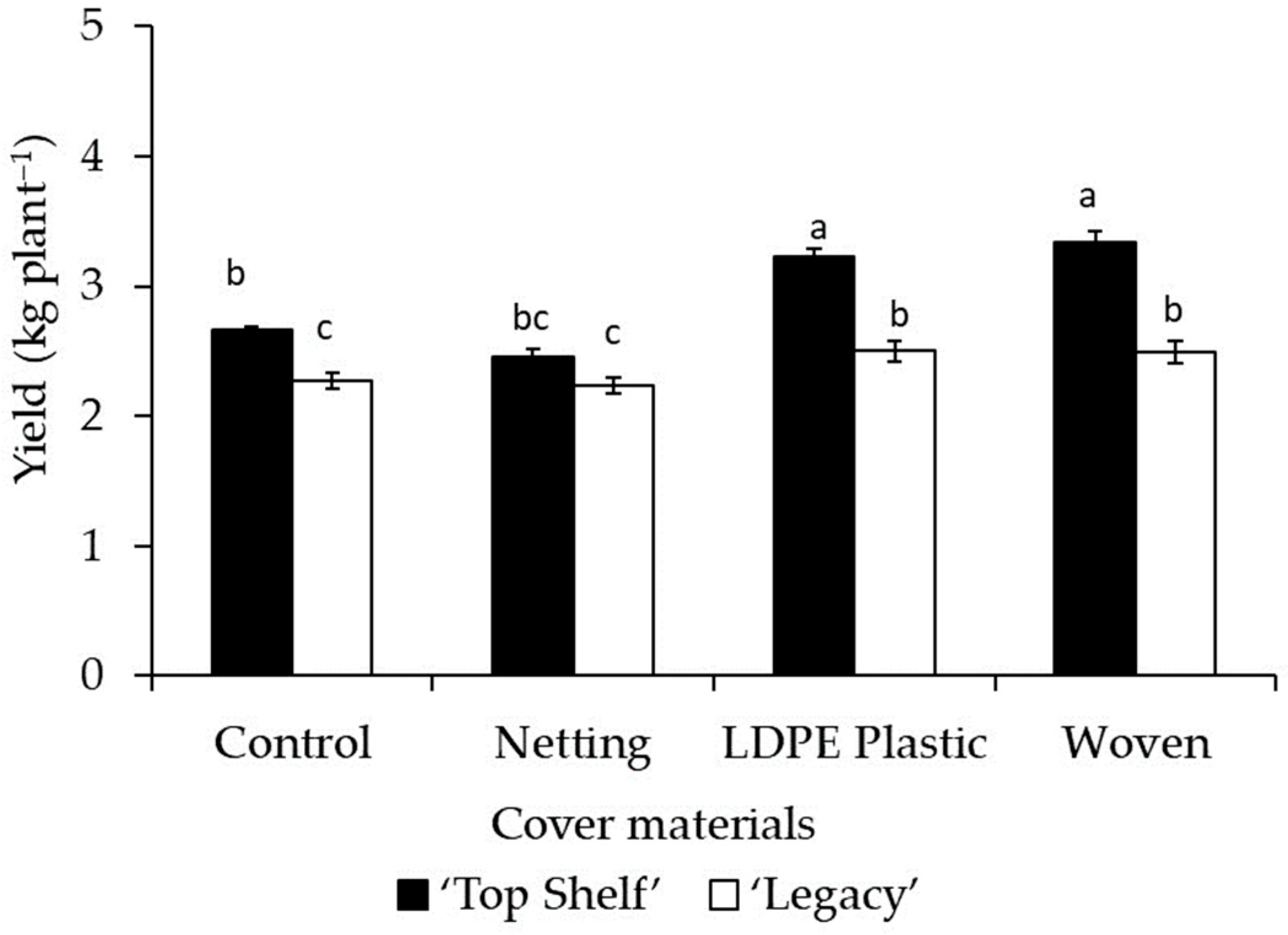

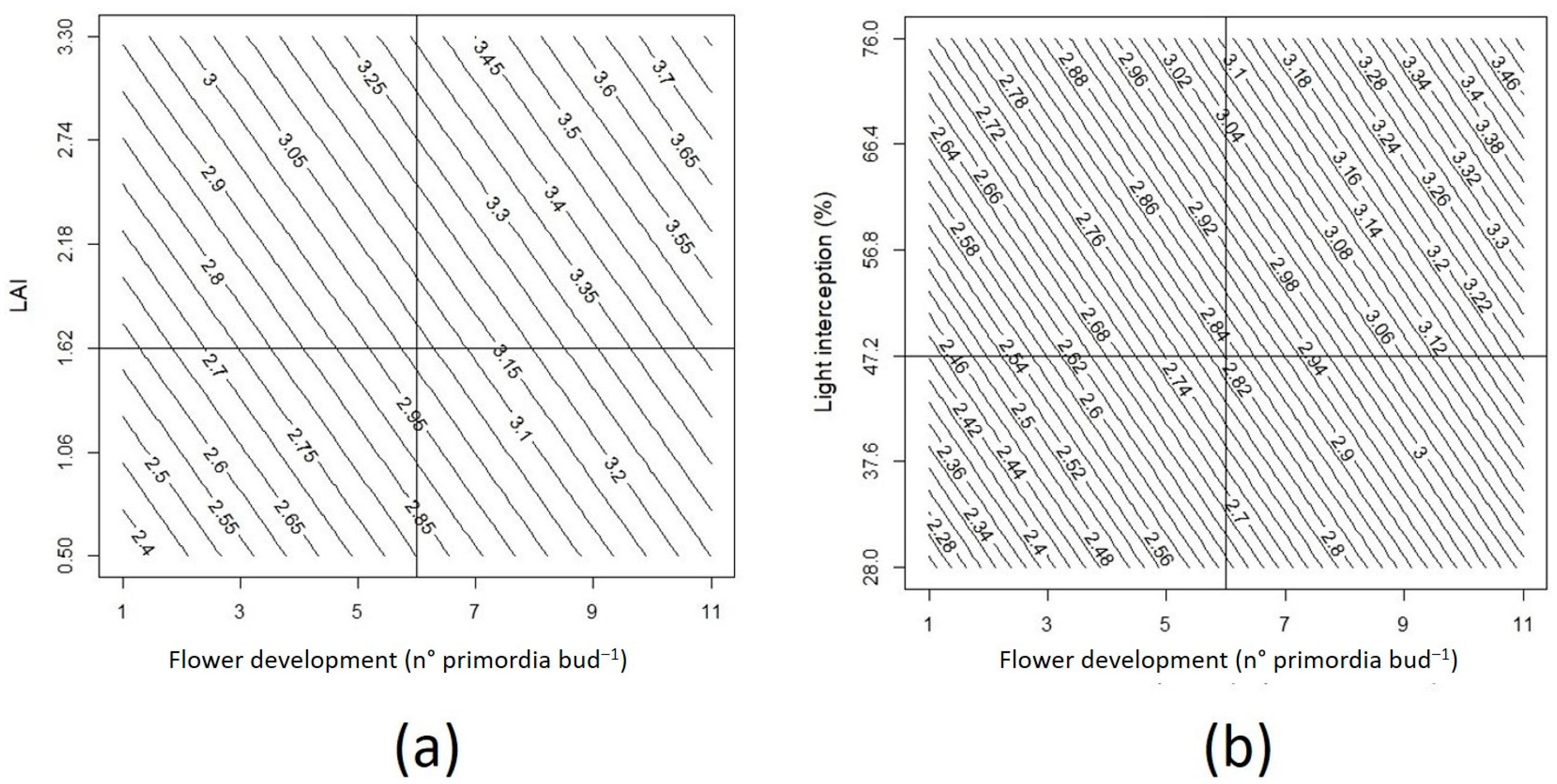

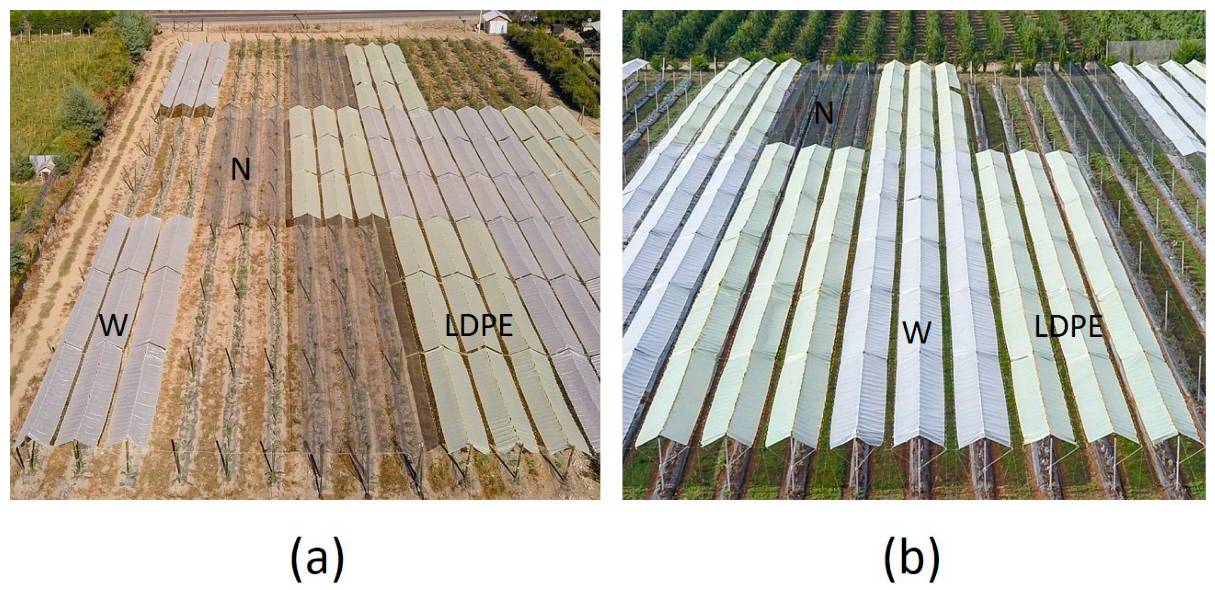
| Treatment | Light Interception | LAI | ||
|---|---|---|---|---|
| (%) | ||||
| Linares | Traiguén | Linares | Traiguén | |
| Cover Materials (Cm) | ||||
| Control | 46.18 c | 37.21 b | 1.78 b | 1.11 b |
| Netting | 56.3 b | 49.73 a | 2.05 ab | 1.4 a |
| LDPE Plastic | 66.34 a | 58.85 a | 2.47 a | 1.72 a |
| Woven | 66.65 a | 56.8 a | 2.48 a | 1.67 a |
| p-value | <0.0001 *** | <0.0001 *** | <0.0001 *** | <0.0001 *** |
| Cultivar (Cv) | ||||
| Top Shelf | 56.54 b | 49.74 a | 2.02 b | 1.45 a |
| Legacy | 61.2 a | 51.55 a | 2.37 a | 1.5 a |
| p-value | 0.0016 ** | 0.1429 ns | 0.0029 ** | 0.4643 ns |
| p-value Cm × Cv | 0.059 ns | 0.6062 ns | 0.1505 ns | 0.8484 ns |
| Treatment | Yield | Diameter | Firmness | Soluble Solids (SS) (°Brix) | Acidity (A) | SS/A Ratio |
|---|---|---|---|---|---|---|
| (kg Plant−1) | (mm) | (g mm−1) | (% Citric Acid) | |||
| Cover Materials (Cm) | ||||||
| Control | 2.466 b | 15.750 a | 147.500 b | 14.401 b | 0.331 a | 57.816 a |
| Netting | 2.344 b | 16.250 a | 152.813 a | 14.036 c | 0.338 a | 46.699 a |
| LDPE Plastic | 2.863 a | 16.750 a | 138.625 d | 14.604 a | 0.348 a | 44.893 a |
| Woven | 2.911 a | 16.125 a | 143.063 c | 14.394 b | 0.376 a | 47.666 a |
| p-value | <0.0001 *** | 0.0858 ns | <0.0001 *** | <0.0001 *** | 0.8907 ns | 0.4418 ns |
| Cultivar (Cv) | ||||||
| Top Shelf | 2.918 a | 17.094 a | 145.969 a | 14.547 a | 0.332 a | 48.983 a |
| Legacy | 2.374 b | 15.344 b | 145.031 a | 14.171 b | 0.365 a | 49.554 a |
| p-value | 0.0004 *** | 0.0009 *** | 0.1298 ns | 0.0055 ** | 0.2775 ns | 0.9446 ns |
| p-value Cm × Cv | 0.0011 ** | 0.1434 ns | 0.4779 ns | 0.4613 ns | 0.6198 ns | 0.3320 ns |
| Treatment | Yield | Diameter | Firmness | Solid Solubles (SS) (°Brix) | Acidity (A) | SS/A Ratio |
|---|---|---|---|---|---|---|
| (kg Plant−1) | (mm) | (g mm−1) | (% Citric Acid) | |||
| Cover Materials (Cm) | ||||||
| Control | 3.566 b | 15.250 a | 151.750 b | 13.836 a | 0.434 a | 33.643 a |
| Netting | 3.098 c | 14.750 a | 157.813 a | 13.509 b | 0.489 a | 31.080 a |
| LDPE Plastic | 3.766 b | 15.375 a | 137.750 d | 13.324 b | 0.393 a | 35.509 a |
| Woven | 4.057 a | 15.438 a | 142.188 c | 13.484 b | 0.424 a | 35.222 a |
| p-value | <0.0001 *** | 0.3068 ns | <0.0001 *** | 0.0066 ** | 0.4880 ns | 0.6371 ns |
| Cultivar (Cv) | ||||||
| Top Shelf | 3.800 a | 16.688 a | 156.531 a | 13.549 a | 0.447 a | 32.439 a |
| Legacy | 3.443 b | 13.719 b | 138.219 b | 13.527 a | 0.423 a | 35.288 a |
| p-value | 0.0155 * | 0.0034 ** | <0.0001 *** | 0.6279 ns | 0.5561 ns | 0.4101 ns |
| p-value Cm x Cv | 0.0500 * | 0.7350 ns | 0.0007 *** | 0.0179 * | 0.8059 ns | 0.8764 ns |
| Treatment | Flower Development | Fruit Set | ||
|---|---|---|---|---|
| (n° Primordia Bud−1) | (%) | |||
| Linares | Traiguén | Linares | Traiguén | |
| Cover Materials (Cm) | ||||
| Control | 6.7 a | 7.3 a | 75.5 a | 77.3 b |
| Netting | 6.8 a | 7.8 a | 77.5 a | 85.7 a |
| Plastic | 7.3 a | 7.8 a | 77.4 a | 78.6 b |
| Woven | 6.6 a | 7.7 a | 76.5 a | 80 ab |
| p-value | 0.1402 ns | 0.4754 ns | 0.9033 ns | 0.0183 * |
| Cultivar (Cv) | ||||
| Top Shelf | 7.6 a | 8.3 a | 77.1 a | 80.7 a |
| Legacy | 6.1 b | 7.1 b | 76.4 a | 80.1 a |
| p-value | <0.0001 *** | 0.0003 *** | 0.8424 ns | 0.8559 ns |
| p-value Cm × Cv | 0.542 ns | 0.7244 ns | 0.6607 ns | 0.9429 ns |
Disclaimer/Publisher’s Note: The statements, opinions and data contained in all publications are solely those of the individual author(s) and contributor(s) and not of MDPI and/or the editor(s). MDPI and/or the editor(s) disclaim responsibility for any injury to people or property resulting from any ideas, methods, instructions or products referred to in the content. |
© 2023 by the authors. Licensee MDPI, Basel, Switzerland. This article is an open access article distributed under the terms and conditions of the Creative Commons Attribution (CC BY) license (https://creativecommons.org/licenses/by/4.0/).
Share and Cite
Matamala, M.F.; Bastías, R.M.; Urra, I.; Calderón-Orellana, A.; Campos, J.; Albornoz, K. Rain Cover and Netting Materials Differentially Affect Fruit Yield and Quality Traits in Two Highbush Blueberry Cultivars via Changes in Sunlight and Temperature Conditions. Plants 2023, 12, 3556. https://doi.org/10.3390/plants12203556
Matamala MF, Bastías RM, Urra I, Calderón-Orellana A, Campos J, Albornoz K. Rain Cover and Netting Materials Differentially Affect Fruit Yield and Quality Traits in Two Highbush Blueberry Cultivars via Changes in Sunlight and Temperature Conditions. Plants. 2023; 12(20):3556. https://doi.org/10.3390/plants12203556
Chicago/Turabian StyleMatamala, María F., Richard M. Bastías, Ignacio Urra, Arturo Calderón-Orellana, Jorge Campos, and Karin Albornoz. 2023. "Rain Cover and Netting Materials Differentially Affect Fruit Yield and Quality Traits in Two Highbush Blueberry Cultivars via Changes in Sunlight and Temperature Conditions" Plants 12, no. 20: 3556. https://doi.org/10.3390/plants12203556
APA StyleMatamala, M. F., Bastías, R. M., Urra, I., Calderón-Orellana, A., Campos, J., & Albornoz, K. (2023). Rain Cover and Netting Materials Differentially Affect Fruit Yield and Quality Traits in Two Highbush Blueberry Cultivars via Changes in Sunlight and Temperature Conditions. Plants, 12(20), 3556. https://doi.org/10.3390/plants12203556









